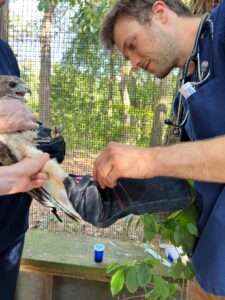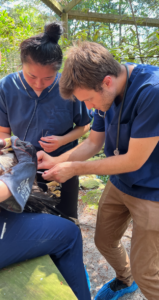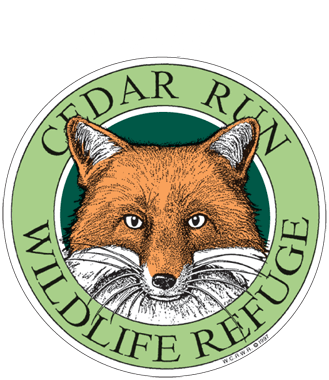Learn how both professions work together and contribute to the treatment and care for wild animals in need to ensure the best chance for survival in the wild.
Written by: Lori Swanson, Director of Wildlife Rehabilitation
January 17, 2024
Upon finding an injured wild animal, the first call people commonly make is to their Veterinarian. They quickly find out that the veterinarian cannot take the wild animal and hopefully are referred to a local Wildlife Rehabilitator. This can be understandably confusing because most people’s only association with animal medical care is with a veterinarian and their pets. However, there are strict federal and state laws in place that dictate who can treat and care for a wild animal in need to ensure that their needs are met appropriately. To achieve this specialized care, Wildlife Rehabilitators and Veterinarians work hand-in-hand.
In the state of New Jersey, and most other states, it is illegal to care for a wild animal without a permit through the State (mammals, reptiles, amphibians, and birds) and the Federal government (migratory birds). These permits are in place to make sure that our native wild animals are receiving the best care from trained and qualified professionals. 
While people from both professions got into their respective fields due to their love of animals and a calling to help in a bigger way, there are many differences that play hand-in-hand with the professional care of animals.
A Wildlife Rehabilitator is someone who has completed an apprenticeship to acquire training on the specific species which they intend to work with and is granted a permit from the government that allows them to legally rehabilitate that species. A Wildlife Rehabilitator is an expert in what the wild species need to survive physically, mentally, and behaviorally. They provide short-term or long-term care for the animals and conduct the treatments prescribed by the Veterinarian and the animals needs until they are released. The State and Federal government will conduct inspections of facilities before granting a permit and will continue with regular inspections to be sure that the Rehabilitator is keeping up with the needs of that species. 
In order to obtain these permits, the Wildlife Rehabilitator is required to have an agreement with a Veterinarian who works alongside them to help meet the medical needs of these wild patients.Veterinarians are legally not allowed to rehabilitate native wild animals without working in conjunction with a Wildlife Rehabilitator, other than providing basic triage. When they do have an agreement with a Wildlife Rehabilitator, the Veterinarian will perform the surgeries and diagnostics needed, as well as provide medications. This is all conducted under their medical license, so Veterinarians have the final say in what medications can and cannot be used at a facility. The relationship between the Rehabilitator and the Veterinarian must be one of respect and trust, allowing both sides to work together and give their opinions and input towards their common goal of providing the best and most humane care for these animals. Most Veterinarians are not able to provide these many services for free, but most will provide a discount with the understanding that they are working with a non-profit organization.

Hopefully, from these two descriptions, you can start to glean why Wildlife Rehabilitators and Veterinarians need to work together to provide well-rounded care for wild species. Veterinarians are exceptional at the nitty gritty medical aspects of wildlife care, but in most cases (removed “unfortunately”) veterinary schools do not include specific courses (removed “training”) on native wildlife’s natural history, behavior, nutrition, etc. Also, Veterinarians do not have the ability to house animals for months at a time or have outdoor enclosures to aid in their recovery. We have seen good intentions go bad when a Veterinarian has treated or raised a wild animal independently which has led to imprinting because they were treated like a domestic animal. We have seen nutritional issues because they have raised a baby with improper formula, unaware of their specialized diets. Wildlife Rehabilitators have spent years improving species-specific care and understand what behaviors, abilities, or limitations that a wild animal can live with to survive in the wild. They have the appropriate space, enclosures, enrichment, and time to devote to long-term care in preparation for release.
At Cedar Run, we have worked closely with Animal and Bird Healthcare Center, located in Cherry Hill, New Jersey, for decades to provide excellent care to our wildlife patients and residents. We could not do our work without their help and support, and we are eternally grateful. Together we are able to provide a bright future and a second chance at life to thousands of wild animals annually.

If you do find yourself in a situation where you find an injured or orphaned wild animal in need of care, please call Cedar Run’s Wildlife Rehabilitation Hospital, or your local licensed Wildlife Rehabilitator, at 856-983-3329 x 107.
It is illegal to possess wildlife in New Jersey without a permit. Injured, orphaned, or ill wildlife must be taken directly to a permitted Wildlife Rehabilitator and cannot be kept or cared for by any individual who does not possess a valid NJ Wildlife Rehabilitation Permit. Do not attempt to care for or raise wild animals yourself – for the health and well-being of the wild animal.
